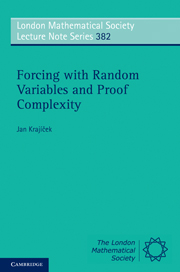Book contents
- Frontmatter
- Contents
- Preface
- Acknowledgements
- Introduction
- PART I BASICS
- PART II SECOND-ORDER STRUCTURES
- PART III AC0 WORLD
- PART IV AC0(2) WORLD
- PART V TOWARDS PROOF COMPLEXITY
- PART VI PROOF COMPLEXITY OF Fd AND Fd (⊕)
- PART VII POLYNOMIAL-TIME AND HIGHER WORLDS
- PART VIII PROOF COMPLEXITY OF EF AND BEYOND
- 27 Fundamental problems in proof complexity
- 28 Theories for EF and stronger proof systems
- 29 Proof complexity generators: definitions and facts
- 30 Proof complexity generators: conjectures
- 31 The local witness model
- Appendix: Non-standard models and the ultrapower construction
- Standard notation, conventions and list of symbols
- References
- Name index
- Subject index
27 - Fundamental problems in proof complexity
Published online by Cambridge University Press: 05 November 2011
- Frontmatter
- Contents
- Preface
- Acknowledgements
- Introduction
- PART I BASICS
- PART II SECOND-ORDER STRUCTURES
- PART III AC0 WORLD
- PART IV AC0(2) WORLD
- PART V TOWARDS PROOF COMPLEXITY
- PART VI PROOF COMPLEXITY OF Fd AND Fd (⊕)
- PART VII POLYNOMIAL-TIME AND HIGHER WORLDS
- PART VIII PROOF COMPLEXITY OF EF AND BEYOND
- 27 Fundamental problems in proof complexity
- 28 Theories for EF and stronger proof systems
- 29 Proof complexity generators: definitions and facts
- 30 Proof complexity generators: conjectures
- 31 The local witness model
- Appendix: Non-standard models and the ultrapower construction
- Standard notation, conventions and list of symbols
- References
- Name index
- Subject index
Summary
In this last part of the book we shall consider strong proof systems. We start by recalling in this chapter briefly a very general background of proof complexity, and by spelling out a few open problems that we consider fundamental for further development. This exposition is included in order to give the reader some idea of what motivates the choice of topics we study in later chapters. Details can be found in the references given in the Introduction (or in the text below).
Cook and Reckhow [31] defined a general proof system for propositional logic to be a polynomial-time computable function P defined on {0,1}* whose range is exactly the set TAUT of propositional tautologies in the DeMorgan language 0, 1, ∧, ∨, ¬ (see Chapter 17). Any string that P maps to a tautology τ is called a P-proof of τ. This definition subsumes the usual calculi for propositional logic that one encounters in textbooks and, in particular, those defined in Chapter 17: given such a calculus interpret it as a function that maps a string that is a valid proof to the formula being proved, and all other strings to some fixed tautology (for example, to 1). Such a function will satisfy the Cook–Reckhow definition as in all logical calculi it is recognizable by a p-time algorithm whether a string is a valid proof or not. Note that the fact that the range of the function constructed in this way from a propositional calculus is exactly the set TAUT is equivalent to the soundness and the completeness of the calculus.
Information
- Type
- Chapter
- Information
- Forcing with Random Variables and Proof Complexity , pp. 173 - 178Publisher: Cambridge University PressPrint publication year: 2010
